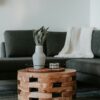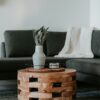Coffee Tables Through History
Exploring the story of coffee tables takes us from elegant European lounges to cozy modern living rooms. Dive with me into the colorful journey of these humble tables and witness their makeover through the ages.
Origins in European Salons
Our story starts in the vibrant days of the Ottoman Empire, where low tables were all the rage at tea and coffee gatherings. Picture it like early social media—people connecting over cups and conversations. These tables, acting like social magnets, sauntered into European salons by the late 1700s.
Victoria’s times saw a swift shift—the tea table smoothly morphed into what’s now called a coffee table. Coffee became the rockstar of social occasions, propelling these tables into British homes’ must-have list. Then came the TV boom of the 20th century, pushing the coffee table into the forefront of living room design.
Evolution into Modern Living Spaces
As I dug around the coffee table’s timeline, the drastic shifts in style and purpose got me hooked. Today’s coffee tables scream personality and are often the star of interior décor. Goodbye, boring wooden blocks—hello to metal, glass, and cool tech gadgets like charging stations (Wood Passion).
As houses evolved, so did coffee tables, morphing into multifunctional pieces—a blend of beauty and service. Influences like the Anglo-Japanese design gave birth to lower, longer tables, shaking up tastes along the way (Laurel Crown).
Key Features Over Time
| Era | Key Characteristics |
|---|---|
| Ottoman Empire | Low tables for tea and coffee meet-and-greets |
| 18th Century Europe | Tea tables rise up, becoming social butterflies |
| Victorian Era | Tea’s out; coffee’s in, bringing flair and formality |
| 20th Century | TV buddies; versatile and ready for living room action |
| Modern Times | Mix of metals and tech; charging up with innovation |
Throughout history, coffee tables have sat center stage, changing with the times from plush European settings to today’s chic living spaces. This saga emphasizes their timeless charm and adaptability. For a deeper dive on coffee table evolution and insights on iconic designs, check out our stories.
The Victorian Era Influence
The Victorian era had a huge impact on the coffee table’s journey from simple tea tables to the well-loved coffee tables we see in living rooms today. Here’s my take on how this era shaped those tables.
Kickoff in the Living Room
Back in the Victorian days, living rooms were where all the social magic happened. People wanted these rooms to look nice but also be practical, and so the coffee table started to make its entrance as a must-have piece of furniture. If we look back at its roots, the coffee table owes a lot to the Ottoman Empire, where folks used low tables for tea and coffee gatherings (Vanity Living).
These low tables began popping up in British homes, thanks to the Victorian trendsetters. They were simple—just low enough and small enough to hold coffee or tea for guests without a fuss (JasonL).
| Thingamajig | What’s the Deal? |
|---|---|
| Height | Low enough for comfy serving |
| Surface | Flat to hold cups and tiny knick-knacks |
| Influence | Borrowed the style from Ottoman tea times |
| Popularity | Became the thing in those posh Victorian rooms |
Tea Tables Get a Coffee Makeover
Fast forward through the Victorian years, and coffee tables started stealing the spotlight from their tea-serving cousins. Tea drinking was huge back then, but with coffeehouses sprouting up everywhere, folks were slurping more coffee. And, voilà! A new kind of table was born for these coffee moments (Laurel Crown).
The table designs got a makeover—less frills, more function, tapping into styles from the Ottoman crowd and a dash of Anglo-Japanese flair. Tall and showy took a step back for tables that were longer and lower—perfect for chit-chat and hanging out. The coffee table became the heart of the room, showing how people were moving from stiff gatherings to just chilling with friends.
If you’re the type who gets all giddy over antique coffee tables, this story gives those old pieces some serious street cred. They don’t just hold stuff; they tell tales of changing times and tastes. For more tales on how coffee tables evolved through taste and design shifts, check out our stories on coffee table aesthetics evolution and antique coffee table evolution.
Modern Coffee Table Varieties
In my journey exploring how coffee tables have changed over time, I’ve stumbled upon a fascinating world of modern coffee tables loaded with cool features and creative materials.
Functional Features
Today’s coffee tables aren’t just flat surfaces where you dump stuff anymore; they’ve gotten fancy. Think drawers for hiding your remote, shelves for your books, and even snazzy built-in lights that create a cozy glow. And there’s more! Some tables can even change their height – perfect for those times when you need a quick boost or want to adapt to different seating situations.
| Feature | Description |
|---|---|
| Drawers | Handy spots to squirrel away your magazines, remotes, and tiny knick-knacks. |
| Shelves | A place to prop up books or show off your favorite decorations. |
| Built-in Lighting | Sets the mood and highlights your décor, giving your room a warm glow. |
| Adjustable Height | Lets you tweak the table’s height to match your setup or mood. |
Making tweaks to your coffee table, like adding a shelf or swapping legs, is all the rage. It turns your table into an extension of your personality (This Old House). Curious about what’s trending? Check out our article on modern coffee table trends.
Variety in Materials
Modern coffee tables have waved goodbye to plain old wood. Now it’s all about embracing metals like steel or aluminum, and sassy materials like glass, acrylic, and marble (Belare Home). Each material offers a unique vibe and uses, from the cozy warmth of wood to the slick toughness of metal.
| Material | Characteristics |
|---|---|
| Wood | A timeless favorite; can swing between rustic and elegant based on the finish. |
| Metal | Strong and stylish; gives a modern and edgy look, thanks to metals like steel and aluminum. |
| Glass | Brings in a touch of class and transparency, often paired with other materials for effect. |
| Acrylic | Lightweight and trendy, offering a modern twist with a sleek, no-fuss vibe. |
| Marble | All about opulence and class, giving spaces a touch of luxury. |
By mixing up materials, coffee tables have become more than just functional. They’re now centerpieces that reflect who you are and how you live. Looking ahead, you can bet on tables focusing on eco-friendliness, techy features, multi-use, and personal customization (Belare Home). For a look back at how it all began, check out our article on the evolution of coffee tables.
Unique Design Trends
While digging into the evolution of coffee tables, I noticed how styles are changing to mix usefulness, looks, and planet-friendly vibes. Two big trends caught my eye: personalization and recycling, and going green.
Customization & Repurposing
In today’s coffee table world, it’s all about making it your own and giving old stuff a second life. Folks now can whip up custom pieces that scream their style and check off their wishlist. Want a taller table or extra storage? Swap out those legs with simple changes (This Old House).
Artisans and those who love a good DIY project are getting creative, turning old doors or vintage suitcases into coffee tables that stand out. It breathes new life into forgotten stuff and adds a cool backstory to your living room focal point.
| Customization Options | Examples |
|---|---|
| Adjust Height | Taller for snacks, lower for lounging |
| Add Shelf | Stash your books and treasures |
| Change Leg Style | Go from wood to funky metal or sleek acrylic |
Embracing Sustainability
I’ve also noticed more folks focusing on planet-friendly coffee tables. The push to use eco-materials helps reduce our impact on Mother Earth. People are loving tables made from recycled stuff like metal or wood (Vanity Living). You’ll see options like bamboo, too, which is kind to the environment.
Sustainable tables don’t stop at just what they’re made of. It’s all about clever designs that do more with less. Picture a table with secret storage, adjustable parts, or even built-in lights to cut down on waste (Vanity Living).
| Sustainable Material | Example Uses |
|---|---|
| Reclaimed Wood | Gives off cozy vintage vibes |
| Recycled Metal | Perfect for that urban chic feel |
| Bamboo | Earth-friendly and light as a feather |
The path forward for coffee tables connects the dots between green choices, tech-savvy elements, and designs that do more than just sit there (Belare Home). As our living spaces continue to grow, it’s exciting to see these trends shape our homes while caring for our planet.
For more deep dives into cool coffee table designs, check out my full breakdown on iconic coffee table designs.
Office Decor & Coffee Tables
Getting into the story of coffee tables, it’s pretty wild how they’ve managed to slide their way into office spaces. Their role in changing workplace vibes is quite impressive.
Versatility in Workplace Settings
Coffee tables are now staples in the modern office because they’re like Swiss Army knives. They bring people together, turning into hotspots for team chats and idea bounces (check out JasonL). They’re great for everything from speed-meetings to brainwave-storming sessions.
| Functionality | Benefits |
|---|---|
| Meeting Facilitation | Brings folks together |
| Versatile Workspaces | Flexible spots for everyone |
| Aesthetic Appeal | Spruces up the office |
Plus, these tables say a lot about a company’s style and spruce up the place. They’re perfect spots for sharing ideas or just chilling out, which keeps people happy and relaxed at work (JasonL). They can even come with USB ports and storage, making them super handy.
Curious about where coffee tables started? I’ve got your back with more on coffee table furniture history.
Impact on Productivity & Collaboration
Where you put a coffee table can really make a difference in how people work together. These tables create laid-back spots for chats, sparking new ideas and improving how folks communicate (source: JasonL). This ups morale and nurtures a friendly work atmosphere.
| Impact | Benefits |
|---|---|
| Boosts Productivity | Supports adaptable work styles |
| Enhances Teamwork | Good for informal meetups |
| Positive Work Vibes | Encourages open communication and fresh ideas |
Having coffee tables around amps up team spirit, offering comfy, engaging spots where people can think, work, or unwind. Their clever designs mean everyone can use them to their advantage, whether for knocking out tasks or just taking a breather.
See how the latest styles have influenced coffee tables by checking out our piece on iconic coffee table designs.
Styling for Modern Spaces
When thinking about how the humble coffee table has changed over time, it’s crucial to balance looks with practicality. In today’s offices, these tables aren’t just pretty faces—they’re versatile workhorses that boost both style and function.
Popular Office Styles
Office vibes really influence the type of coffee table that works best. Here’s what I’ve seen making waves lately:
- Contemporary and Minimalist: Think clean lines and unfussy shapes. These are perfect for a slick, tidy appearance.
- Industrial: Made with stuff like metal and reclaimed wood, these tables bring a bit of grit and character to any spot.
- Mid-Century Modern: They’ve got those sleek lines and unique shapes that shout ‘cool retro’ without losing any modern practicality.
- Scandinavian: Known for simplicity and usefulness, these tables use light woods and calming colors.
- Rustic: With worn wood and natural finishes, they add a homey, warm touch.
- High-Tech: Loaded with techie goodies—like charging ports and secret storage—these tables turn up the efficiency dial.
- Custom Creations: Sometimes, you just need something special. Custom tables offer fresh mixes of materials and features that suit unique needs.
Here’s a quick guide to these styles and their standout features:
| Style | Cool Features |
|---|---|
| Contemporary and Minimalist | Sleek and simple |
| Industrial | Metal and reclaimed wood |
| Mid-Century Modern | Tapered legs, funky shapes |
| Scandinavian | Light wood, chill colors |
| Rustic | Distressed wood, earthy vibes |
| High-Tech | Fancy ports, hidden spaces |
| Custom Creations | Tailor-made marvels |
Functionality & Aesthetics
Coffee tables aren’t just there to look good—they’re the unsung heroes of office life, playing all sorts of roles:
- Casual Meetings: A coffee table makes those impromptu chats or brainstorming sessions more laid-back and productive.
- Boosting Efficiency: Tables with chargers and cubbies make sure gadgets stay powered up and organized.
- Corporate Personality: The way a coffee table looks can mirror a company’s character—from the minimalist tech startup to the laid-back, eco-friendly firm.
- Adaptable Workspaces: Whether you need a focused area or a collab space, coffee tables can fit right in.
- Chill Zones: Perfectly positioned tables with cozy seats nearby give folks a spot to unwind, boosting both comfort and morale.
Choosing the right coffee table can make a big difference in your office’s functionality and style. From the legendary tables of yesteryear to today’s flexible designs, the coffee table continues to reinvent itself, making office spaces not just functional but stylish too.









